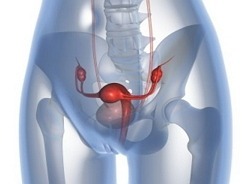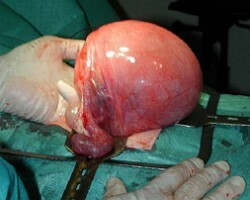Opposimenorrhea
 Opsoenomena are uncharacteristic for a normal cycle of meager menstruation. The duration of bleeding with opdomenoree does not exceed three days, and menstruation itself does not occur more than once every five weeks and less frequently. Scarce menstruation can be temporary and easily amenable to correction, and may be a symptom of a serious gynecological disease, for example, polycystic ovary, hypomenstrual syndrome, infertility or delayed sexual development.
Opsoenomena are uncharacteristic for a normal cycle of meager menstruation. The duration of bleeding with opdomenoree does not exceed three days, and menstruation itself does not occur more than once every five weeks and less frequently. Scarce menstruation can be temporary and easily amenable to correction, and may be a symptom of a serious gynecological disease, for example, polycystic ovary, hypomenstrual syndrome, infertility or delayed sexual development.
Opposomenorrhea, like almost all disorders of the menstrual cycle, can have a physiological character in the period of the onset of menstrual function( pubertal), when the physiological hormonal background is only being formed. Not a serious violation of meager menstruation and in the menopause, when the hormonal function fades.
A normal menstrual cycle forms two phases, controlled by the central nervous system( hypothalamus) and hormones of the pituitary and ovaries. In the first phase, the follicle-stimulating hormone( FSH) predominates, responsible for proliferation( proliferation) of the inner layer of the uterus, endometrium. The second phase is accompanied by the processes of preparation of the enlarged endometrium to rejection, is controlled by luteinizing hormone( LH) and progesterone. The first phase of the cycle is called the phase of proliferation, or the folliculin phase, and the second - the phase of secretion, or the luteal phase. In parallel with the intrauterine changes in the ovaries, a follicle( a "vesicle" with a membrane) ripens, inside which an egg is formed. In the middle of the menstrual cycle, there is a change in the dominant hormones, leading to the release of a mature ovum - ovulation. The ability to conceive is determined by the presence of a two-phase menstrual cycle and ovulation. In patients with opsonomenia, the ratio of the phases of the cycle changes and the probability of ovulation decreases.
Regular menstruation is considered to be physiological with an interval of 25 to 30 days and a duration of at least five days. The blood loss during normal menstruation is individual, but should not be less than 40 ml.
The frequent formulation of the diagnosis as nmts oposomenorea means the belonging of the opsoniformes to a large group of disorders having a common nature and principles of therapy.
Causes of opdomenorei
At the heart of oposomenorei is a violation of the mechanism of the normal menstrual cycle while maintaining its biphasic nature. The change in the proper hormonal ratio provokes a change in the duration of one of the phases of the cycle, and ovulation is either absent or becomes inadequate.
About primary otformenorey speak, if its causes are abnormalities( malformations) of the development of the genitals or their underdevelopment. Primary otformenoreya appears with the first( usually late) menstruation and is present at the girl constantly.
Secondary otformenrhea develops against the background of a normal menstrual cycle under the influence of provocative causes. The causes of secondary opdomenorei may be either violations in the menstrual cycle control system( pituitary-hypothalamus), or undesirable changes directly in the uterus and / or appendages.
Changes in the character of menstruation according to the scenario of opsoniformes can be associated with disorders of the psychoemotional sphere, endocrine diseases, slow infectious processes, traumatic surgical interventions( abortion, diagnostic curettage, resection or removal of the ovary).
Sometimes oposomenorea is part of the physiological process and is not considered an alarming symptom. During the period of menstrual function formation, short-term omnemenorrhea is not classified as a deviation, as in the premenopausal period, when the gradual extinction of menstrual function is part of the physiological age-related changes.
Symptoms of the opromenorei
Opmomenoreia is not an independent disease and enters the clinic of other diseases as a symptom of "meager menstruation."All other clinical signs will be due to the disease that accompanies oposomenorea.
Menstruation rarely comes in the form of "traces" or drops. The menstrual cycle remains biphasic, but the duration of the phases varies according to the type of shortening or elongation, which leads to a disruption in the phase of maturation of the follicle and distortion of the ovulation process. Such violations can reduce the chances of pregnancy.
Often, otomenorrhoea accompanies infertility, hypomenstrual syndrome and polycystic ovary. In this case, otformenorrhea and pregnancy become incompatible.
Prolonged existing oposomenorea can go into amenorrhea - a complete absence of menstruation.
The diagnosis of nmts oposomenorea implies a wide range of diagnostic measures. Examination of patients with oposmenorei begins with the study of complaints. Sometimes the patient can clearly indicate the provoking factor of the appearance of a cycle violation or provide information on non-gynecological diseases that served as a background for opsonomena.
During the general examination, attention is focused on the height and weight of a woman, the severity of secondary sexual characteristics( for female type of hair, etc.), the condition of the skin.
Gynecological examination reveals anomalies in the development of the genitals or the presence of inflammatory processes.
The determination of the nature of hormonal disorders is of primary importance for the resolution of the issue of the possibility of restoring the ability of procreation. The level of FSH, LH, progesterone and prolactin is determined. Sometimes it is required to determine the level of hormones of the thyroid gland and adrenal glands.
If a concomitant inflammatory process is found, laboratory diagnostics is supplemented with analyzes to identify the causative agent of the infection.
Ultrasound helps to clarify the size and degree of development of the genitals, to reveal anatomical defects or the presence of an inflammatory process.
Consultations of related specialists help to identify non-gynecological causes of oposomenorrhea.
Treatment of opromenorei
The volume of therapeutic interventions depends on the disease that oposomenorea accompanies. Also take into account the age of patients, the state of reproductive function and concomitant extragenital pathology.
Congenital malformations of genitalia and severe forms of delay in puberty are not amenable to therapy, the possibility of its application is solved together with endocrinologists, geneticists and surgeons.
Therapy of opsonenorei is to eliminate the cause of the underlying disease that caused it. The leading method of treatment is hormone therapy in order to restore the normal rhythm of menstruation. Schemes of treatment are selected individually. Infertility after the restoration of the physiological rhythm of menstruation is carried out hormonal stimulation of ovulation. Unfortunately, often opsonomena and pregnancy are not very compatible, but the verdict is ambiguous and depends on the cause of menstrual dysfunction.
Treatment of inflammatory diseases includes the use of antibiotics, immunostimulants and vitamins.
Patients with weight deficiency are selected an adequate full-fledged diet. Often, full nutrition as a treatment for young girls eliminates menstrual irregularities.
Physiotherapy, phytotherapy and gynecological massage are successfully used as a complex therapy.



